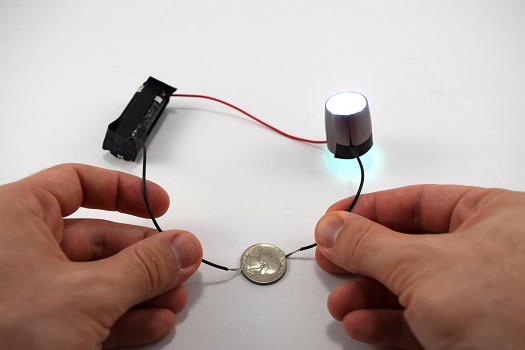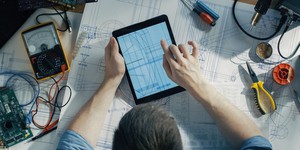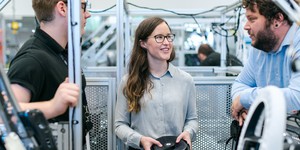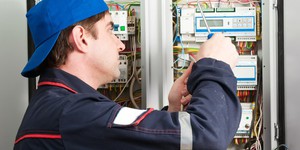Summary

Introduction
Electricity powers many of the devices you use every day. Those devices are made up of circuits, ranging from very simple (like in a lamp with a single light bulb) to very complex (like in a computer). Try this project to build your own simple circuit and use it to test which common household materials conduct electricity.
Background
You probably hear the word "electricity" a lot, but what does it actually mean? In everyday use, electricity typically refers to electrically charged particles (called electrons) moving through metal wires. The flow of electricity is called current. Metals are generally very good conductors, meaning they let current flow easily. Materials that do not let current flow easily are called insulators. Most non-metal materials, like plastic, wood, and rubber, are insulators. You will notice this if you have ever plugged something into a wall outlet. The prongs on the plug, and the wire inside the cord, are metal, but they are surrounded by plastic insulation so you do not get shocked when you touch the cord!
Electricity requires a complete "loop" for current to flow. This is called a closed circuit. That is why wall outlets have two prongs and batteries have two ends (positive and negative) instead of just one. You connect both of them to a circuit and that creates a complete loop. If the loop is broken at all, that is called an open circuit and no current will flow.
In this project you will build your own simple circuit by disassembling a flashlight. You will use your circuit as a tester to determine whether household materials are conductors or insulators. When you connect the circuit to a conductor, you will create a closed circuit and the flashlight bulb will turn on. If you connect the circuit to an insulator, you will still have an open circuit so the bulb will stay off.
Materials
- Flashlight and batteries
- 3 pieces of wire (see procedure)
- Electrical tape
- Scissors
- Assortment of metal and non-metal household materials
Instructions
Caution: electricity from wall outlets is very dangerous. Never cut into a wire or open an electronic device while it is plugged into a wall outlet.
- To do this project you will need to salvage three pieces of wire from an old electronic device. You might have a junk drawer full of old cell phone chargers – those will work great. You can also purchase wire at a hardware store and some craft stores.
- Cut three pieces of wire, each at least 10 cm long.
- Have an adult use scissors or a sharp knife to shave about 1 cm of insulation off each end of the wire, exposing the metal inside. There is also a special tool to do this called wire strippers. You can use those if they are available.
- Disassemble your flashlight. Remove the batteries. If possible, unscrew the "head" (the part that holds the bulb) and remove the on/off switch. Most flashlights can be disassembled easily by hand, but you might need another tool (like a screwdriver) or some help from an adult to do this.
- Examine the inside of your flashlight and try to trace the circuit. Remember that electricity requires a closed circuit to flow. The circuit in a flashlight usually goes from one end of the battery compartment, through an on/off switch, through the bulb, and back to the other end of the battery compartment.
- Your first goal is to use two wires to connect the battery compartment directly to the bulb. This may take some tinkering on your part, since not all flashlights are the same.
- The battery compartment should have "+" and "-" ends. Use electrical tape to attach one end of a wire to the metal parts on each end of the battery compartment. Make sure to squeeze the wires on firmly so they makes good contact.
- Note: if the batteries just slide into the flashlight body (rather than being held in place by clips or springs), use rubber bands to hold them together end-to-end when you remove them from the flashlight.
- Now search for two metal contacts on the bulb housing, and connect the other ends of the wires to those with electrical tape. Note: sometimes the entire inside of the flashlight case is metal, and this serves as one of the contacts.
- If you made the contacts correctly, this should case the bulb to light up. If the bulb does not light up, don't worry! There are a few things you can check.
- You might have an LED flashlight. LED stands for light-emitting diode. LEDs are a special type of light that act like one-way valves for electricity. They only light up when their positive (+) and negative (-) sides are connected the right way. Try reversing how the two wires are connected to the battery pack and see if it lights up.
- Your wires might not be making good contact with the metal in the flashlight circuit. Try pinching the contact points with your fingers, or use something like mini clothespins or binder clips to squeeze the connections.
- You should now have a working circuit. Essentially you have removed the battery and bulb from the flashlight case and re-created the circuit using two wires. You can use this circuit to test the conductivity of household materials by adding a third wire.
- Disconnect the wire from one end of the battery pack. This creates an open circuit, and your bulb should turn off.
- Tape one end of your third wire to that end of the battery pack. Your circuit should now have three wires total, two of which have free ends.
- Touch the two free ends of the wires together. This should create a closed circuit again, and your bulb should turn on.
- Test whether materials are conductive by touching them with both free wire ends at the same time.
- What happens if you touch metal objects like paper clips or aluminum foil? If the bulb turns on, does that mean the material is a conductor or insulator?
- What happens if you touch non-metal objects like wood, plastic, or rubber? Does the bulb turn on or stay off?
Extra: can you find any non-metal conductive materials in your home?
Observations and Results
It may take a bit of work to reverse-engineer a flashlight once you have taken it apart. However, you should be able to get the flashlight to function without its power switch by connecting the battery compartment directly to the bulb using two wires. Adding a third wire allows you to create a "tester." When you touch a metal object with the free wire ends, the bulb should light up just like it would as usual. This works because the metal objects are conductors, so they create a closed circuit. When you touch insulating materials like plastic, rubber, and wood, the circuit is still open, so the bulb stays off because no current can flow.
Non-metal conductive materials can be difficult to find. A graphite pencil core may work for some flashlights, but graphite has a very high resistance compared to metals, so the bulb may appear very dim or not light up at all.
Ask an Expert
Cleanup
- Reassemble your flashlight if you need to use it again, or keep your homemade conductivity tester – up to you!
Additional Resources
- Which materials are the best conductors, from Science Buddies
- Electricity and Magnetism, from Physics4Kids
- Science Activities for All Ages, from Science Buddies









